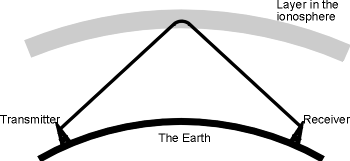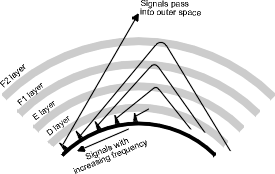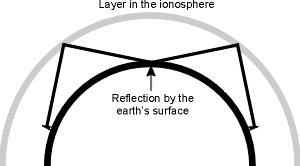HF Ionospheric Radio Signal Propagation
- the basics of HF ionospheric radio propagation and how the ionosphere
enables radio communications links to be established over large distances around
the globe using what are termed sky waves or skywaves.
HF radio communications is dependent for most of its
applications on the use of the ionosphere. This region in the atmosphere enables
radio communications signals to be reflected, or more correctly refracted back
to earth so that they can travel over great distances around the globe.
Ionospheric propagation is normally though of as an HF propagation mode,
although, it use can extend above and below the HF portion of the spectrum on
many occasions.
The fact that radio communications signals can travel all
over the globe on the HF bands is widely used by many by broadcasters, news
agencies, maritime, radio hams and many other users. Radio transmitters using
relatively low powers can be used to communicate to the other side of the globe.
Although radio propagation using the ionosphere may not be not as reliable as
that provided by satellites, it nevertheless provides a very cost effective and
efficient form of radio communication. To enable the most to be made of
ionospheric propagation many radio users make extensive use of HF propagation
programmes to predict the areas of the globe to which signals may travel, or the
probability of them reaching a given area.
These HF propagation prediction programmes utilise a large
amount of data, and many have been developed over many years, along with data
about the prevailing conditions. However it is still useful to gain a view of
how signals travel when using ionospheric propagation and to understand why
signal conditions change. In this way the best use can be made of ionospheric
propagation.
Radio communications signals in the medium and short wave
bands travel by two basic means. The first is known as a ground wave (covered on
a separate page in this section), and the second a sky wave using the
ionosphere.
Skywaves
When using ionospheric radio propagation, the radio signals
leave the Earth's surface and travel towards the ionosphere where some of these
are returned to Earth. These radio signals are termed sky waves for obvious
reason. If they are returned to Earth, then the ionosphere may (very simply) be
viewed as a vast reflecting surface encompassing the Earth that enables signals
to travel over much greater distances than would otherwise be possible.
Naturally this is a great over simplification because the frequency, time of day
and many other parameters govern the reflection, or more correctly the
refraction of signals back to Earth. There are in fact a number of layers, or
more correctly regions within the ionosphere, and these act in different ways as
described below.
D region
When a sky wave leaves the Earth's surface and travels
upwards, the first region of interest that it reaches in the ionosphere is
called the D region. This region attenuates the signals as they pass through.
The level of attenuation depends on the frequency. Low frequencies are
attenuated more than higher ones. In fact it is found that the attenuation
varies as the inverse square of the frequency, i.e. doubling the frequency
reduces the level of attenuation by a factor of four. This means that low
frequency signals are often prevented from reaching the higher regions, except
at night when the region disappears.
The D region attenuates signals because the radio signals
cause the free electrons in the region to vibrate. As they vibrate the electrons
collide with molecules, and at each collision there is a small loss of energy.
With countless millions of electrons vibrating, the amount of energy loss
becomes noticeable and manifests itself as a reduction in the overall signal
level. The amount of signal loss is dependent upon a number of factors: One is
the number of gas molecules that are present. The greater the number of gas
molecules, the higher the number of collisions and hence the higher the
attenuation. The level of ionisation is also very important. The higher the
level of ionisation, the greater the number of electrons that vibrate and
collide with molecules. The third main factor is the frequency of the signal. As
the frequency increases, the wavelength of the vibration shortens, and the
number of collisions between the free electrons and gas molecules decreases. As
a result signals lower in the radio frequency spectrum are attenuated far more
than those which are higher in frequency. Even so high frequency signals still
suffer some reduction in signal strength.
E and F Regions
Once a signal passes through the D region, it travels on and
reaches first the E, and next the F regions. At the altitude where these regions
are found the air density is very much less, and this means that when the free
electrons are excited by radio signals and vibrate, far fewer collisions occur.
As a result the way in which these regions act is somewhat different. The
electrons are again set in motion by the radio signal, but they tend to
re-radiate it. As the signal is travelling in an area where the density of
electrons is increasing, the further it progresses into the region, the signal
is refracted away from the area of higher electron density. In the case of HF
signals, this refraction is often sufficient to bend them back to earth. In
effect it appears that the region has "reflected" the signal.
The tendency for this "reflection" is dependent upon the
frequency and the angle of incidence. As the frequency increases, it is found
that the amount of refraction decreases until a frequency is reached where the
signals pass through the region and on to the next. Eventually a point is
reached where the signal passes through all the regions and on into outer space.

Refraction of a radio signal as it enters an ionised
region
Different frequencies
To gain a better idea of the characteristics of HF
propagation using the ionosphere, it is worth viewing what happens to a radio
communications signal if the frequency is increased across the frequency
spectrum. First it starts with a signal in the medium wave broadcast band.
During the day signals on these frequencies only propagate using the ground
wave. Any signals that reach the D region are absorbed. However at night as the
D region disappears signals reach the other regions and may be heard over much
greater distances.
If the frequency of the signal is increased, a point is
reached where the signal starts to penetrate the D region and signals reach the
E region. Here it is reflected and will pass back through the D region and
return to earth a considerable distance away from the transmitter.
As the frequency is increased further the signal is refracted
less and less by the E region and eventually it passes right through. It then
reaches the F1 region and here it may be reflected passing back through the D
and E regions to reach the earth again. As the F1 region is higher than the E
region the distance reached will be greater than that for an E region
reflection.
Finally as the frequency of the radio communications signal
rises still further the it will eventually pass through the F1 region and onto
the F2 region. This is the highest of the regions in the ionosphere and the
distances reached using this are the greatest. As a rough guide the maximum skip
distance for the E region is around 2500 km and 5000 km for the F2 region.

Signals reflected by the E and F regions
Multiple hops
Whilst it is possible to reach considerable distances using
the F region as already described, on its own this does not explain the fact
that radio signals are regularly heard from opposite sides of the globe using HF
propagation with the ionosphere. This occurs because the signals are able to
undergo several "reflections". Once the signals are returned to earth from the
ionosphere, they are reflected back upwards by the earth's surface, and again
they are able to undergo another "reflection" by the ionosphere. Naturally the
signal is reduced in strength at each "reflection", and it is also found that
different areas of the Earth reflect radio signals differently. As might be
anticipated the surface of the sea is a very good reflector, whereas desert
areas are very poor. This means that signals that are "reflected" back to the
ionosphere by the Pacific or Atlantic oceans will be stronger than those that
use the Sahara desert or the red centre of Australia.

Multiple reflections
It is not just the Earth's surface that introduces losses
into the signal path. In fact the major cause of loss is the D region, even for
frequencies high up into the HF portion of the spectrum. One of the reasons for
this is that the signal has to pass through the D region twice for every
reflection by the ionosphere. This means that to get the best signal strengths
it is necessary signal paths enable the minimum number of hops to be used. This
is generally achieved using frequencies close to the maximum frequencies that
can support communications using ionospheric propagation, and thereby using the
highest regions in the ionosphere. In addition to this the level of attenuation
introduced by the D region is also reduced. This means that a radio signal on 20
MHz for example will be stronger than one on 10 MHz if propagation can be
supported at both frequencies.
HF propagation summary
HF propagation using the ionosphere is still a widely used as
a form of radio communications. While not as reliable as satellite
communications, it is not nearly as expensive, and can provide a useful back-up
in case the satellite communications fail. It is also widely used as the primary
form of radio communications by many organisations from radio broadcasters to
radio amateurs, as well as ship to shore and many other forms of point to point
communications. As a result HF propagation using the ionosphere is likely to
remain in use indefinitely as a form of radio communications technology.
|

